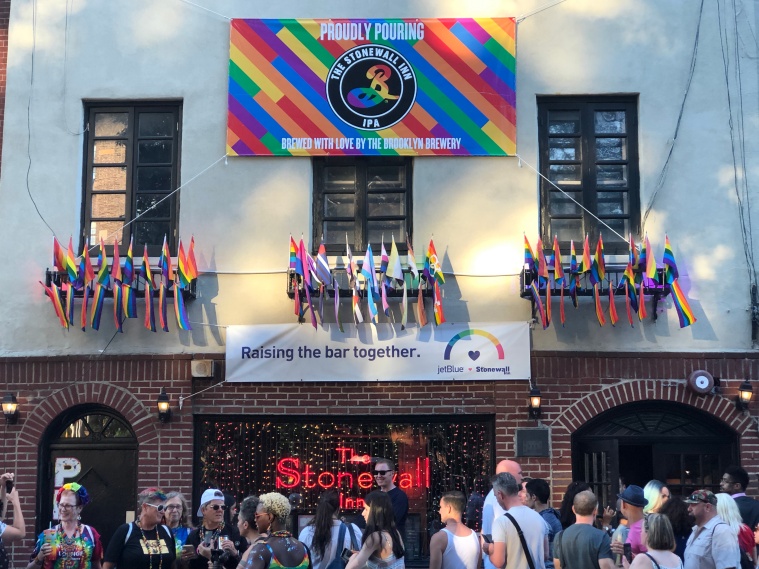Explained: Why Pride Month matters, and the role of the Stonewall Inn riots
The month of June is now commemorated as Pride Month, with inclusive parades, marches, festivals, and workshops to spread awareness about, celebrate, and acknowledge queer history, and to create an accepting space.
 At the Stonewall Inn in New York City during Pride Month, 2019. (Photo: Monojit Majumdar)
At the Stonewall Inn in New York City during Pride Month, 2019. (Photo: Monojit Majumdar)Written by Jayati Tripathi
A landmark in queer history was reached more than fifty years ago, when riots erupted at the Stonewall Inn in New York City, giving birth to the current celebration of Pride Month and the institutionalisation of the international LGBTQIA+ movement.
The month of June is now commemorated as Pride Month, with inclusive parades, marches, festivals, and workshops to spread awareness about, celebrate, and acknowledge queer history, and to create an accepting space.
America in the 50s and 60s
Transgressing societal norms of heterosexuality was met with suspicion and anger in the 1950s and 60s, and public demonstrations of homosexuality were considered a criminal offence in the majority of American states.
Queer people were driven to the fringes, finding shelter in illegal establishments and bars where they could congregate and express themselves. Often such bars were owned by organised crime groups, leading to frequent police raids.
The Stonewall Inn in New York’s Greenwich Village was one such popular enterprise. Early on June 28, 1969, the NYPD conducted a raid at Stonewall on the pretext of stopping the sale of unlicensed liquor. The employees were arrested, the bar was cleared, and many were taken into custody. Though this was not an uncommon occurrence, it was the events that followed which charted the path forward for queer acceptance and assimilation.
What happened at Stonewall
Instead of retreating, people gathered within and outside the Inn stood their ground. They watched as people were forced into police vehicles and driven to lock-ups, and jeered and threw bottles at law enforcement officers. Police were forced to call in reinforcements, and take refuge in the very bar they raided.
As the number of protesters grew to almost 400, there was arson. The protests continued for the next week, and are collectively referred to as the Stonewall riots or uprising.
 The Stonewall uprising captured the imagination of contemporary queer folk and activists, as also several filmmakers and artists, who over the years, sought to memoralise the protests. (Photo: Monojit Majumdar)
The Stonewall uprising captured the imagination of contemporary queer folk and activists, as also several filmmakers and artists, who over the years, sought to memoralise the protests. (Photo: Monojit Majumdar)
Sociologists and historians characterise the riots as a movement against police brutality and harrasment, and the discriminatory practices suffered by queer people for decades. At the cusp of completing half a century to the riots, the police commissioner of the New York Police Department released a formal apology saying, “The actions taken by the NYPD were wrong — plain and simple.”
Set in the background of anti-war movements and feminist and civil rights agitations, the Stonewall riots expanded the landscape of protest culture, both in America and the world.
The birth of gay pride
The template for a march at the one-year anniversary of the riots was floated by activists in Philadelphia at a conference, and its theme, “gay pride”, was a reference to the sense of pride and oneness members of the community felt in their sexual and gender identities. The procession, which came to be known as the Christopher Street Liberation Day march to mark the street at the heart of the protests, grew from a few hundreds to thousands of members and allies.
Similar events were staged in Los Angeles and San Francisco, and subsequently ‘Gay or LGBTQ Pride’ was understood to be celebrated on the last Sunday in June. Over the years, Pride turned into a month-long event, and was accorded official recognition by President Bill Clinton in 1999.
America’s celebration of Pride was adopted across the world, with regional variations celebrating unique cultures and individual activists in a bid to make the movement more inclusive, and to move from the dominant narrative.
Lasting impact of the riots
The Stonewall uprising captured the imagination of contemporary queer folk and activists, as also several filmmakers and artists, who over the years, sought to memorialise the protests. The name of Marsha Johnson — a black trans activist who threw the first brick at Stonewall — as well as those of Stormé DeLarverie and Sylvia Rivera came to occupy centerstage in public speeches and events.
While impulses that identified beyond gender binaries and heterosexuality had been at work long before Stonewall, the riots galvanised the movement and gave it a public face. Pride Month has come to embody that sense of fearless identity and proud unity.
(The writer is an intern with The Indian Express)
- 01
- 02
- 03
- 04
- 05





































